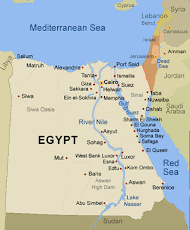 The Nile is the longest river in the world. It runs for about 6,400 km (4,000 miles), starting in the south in eastern Africa and ending in Egypt at the Mediterranean Sea. Southern Egypt, which is upstream, is thus called Upper Egypt, and northern Egypt, being downstream and the Delta, is called Lower Egypt.
The Nile is the longest river in the world. It runs for about 6,400 km (4,000 miles), starting in the south in eastern Africa and ending in Egypt at the Mediterranean Sea. Southern Egypt, which is upstream, is thus called Upper Egypt, and northern Egypt, being downstream and the Delta, is called Lower Egypt.When one cruises on the Nile, one might pass by the ancient and significant sites of Karnak, Luxor, on the other side of the river from Karnak, Dendera, with its grand temple to the goddess Hathor, Abydos, with its marvelous temple built by Seti I as well as being the site of Earlier Dynastic tombs, Esna, with its temple to the potter and creator-god Khnum, lord of the region who was credited as having the power over the river and its richness, Edfu, with its temple to Horus, Kom Ombo, with its double temple to Sobek and a form of Horus called Haroeris, and Aswan itself, with its mighty modern dam.
An interesting fact is that the river has changed its location and size over millions of years.
The ancient Egyptian calendar, made up of twelve months of 30 days each, was divided into three seasons, based upon the cycles of the Nile. The three seasons were: akhet, Inundation, peret, the growing season, and shemu, the drought or harvest season. During the season of the Inundation, layers of fertile soil were annually deposited on the flood-plain.








